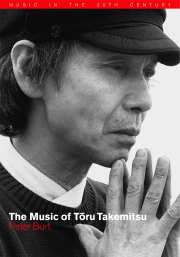Book contents
- Frontmatter
- Contents
- Acknowledgements
- Note on conventions
- Introduction
- 1 Pre-history: how Western music came to Japan
- 2 Music and ‘pre-music’: Takemitsu's early years
- 3 Experimental workshop: the years of Jikken Kōbō
- 4 The Requiem and its reception
- 5 Projections on to a Western mirror
- 6 ‘Cage shock’ and after
- 7 Projections on to an Eastern mirror
- 8 Modernist apogee: the early 1970s
- 9 Descent into the pentagonal garden
- 10 Towards the sea of tonality: the works of the 1980s
- 11 Beyond the far calls: the final years
- 12 Swimming in the ocean that has no West or East
- Notes
- List of Takemitsu's Works
- Select bibliography
- Index
6 - ‘Cage shock’ and after
Published online by Cambridge University Press: 18 August 2009
- Frontmatter
- Contents
- Acknowledgements
- Note on conventions
- Introduction
- 1 Pre-history: how Western music came to Japan
- 2 Music and ‘pre-music’: Takemitsu's early years
- 3 Experimental workshop: the years of Jikken Kōbō
- 4 The Requiem and its reception
- 5 Projections on to a Western mirror
- 6 ‘Cage shock’ and after
- 7 Projections on to an Eastern mirror
- 8 Modernist apogee: the early 1970s
- 9 Descent into the pentagonal garden
- 10 Towards the sea of tonality: the works of the 1980s
- 11 Beyond the far calls: the final years
- 12 Swimming in the ocean that has no West or East
- Notes
- List of Takemitsu's Works
- Select bibliography
- Index
Summary
The unconscious parallels that existed between the ideals and performance practices of the Jikken Kōbō and those of the New York ‘experimental school’ have already been commented upon. It is, therefore, perhaps no surprise to learn that as early as ‘shortly after the war’, and via the ‘intellectual antennae’ of two figures intimately associated with the group's foundation – Shūzo Takiguchi and Kuniharu Akiyama – Takemitsu had already begun to hear about John Cage's innovations. He was to gain more direct knowledge of the new possibilities the composer had uncovered after 1961, when Toshi Ichiyanagi returned from his nine years of study in the United States, which had included attendance at Cage's composition class. In particular, a performance which Ichiyanagi gave in August of that year, at the fourth ōsaka Contemporary Music Festival, of Cage's Concert for Piano and Orchestra, made such a deep impression on Takemitsu that, thirty-one years later, writing an obituary notice for Cage, he could comment that ‘I still feel the shock of hearing that piece’. The works written under the influence of what Ohtake refers to as this ‘Cage shock’ form the matter for discussion in the first part of this chapter.
Graphic scores and indeterminacy
Although there is evidence that Takemitsu had absorbed a number of the American composer's ideas as early as 1956, it is after Ichiyanagi's return from the United States in 1961 that his period of intensest involvement with the theories of Cage really begins. Indeed, Ichiyanagi himself was directly involved in Takemitsu's first experiment with one of Cage's most celebrated ‘inventions’, the prepared piano.
- Type
- Chapter
- Information
- The Music of Toru Takemitsu , pp. 92 - 109Publisher: Cambridge University PressPrint publication year: 2001



